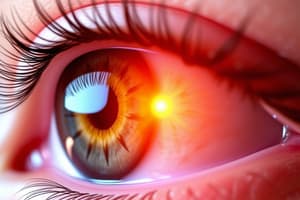Podcast
Questions and Answers
What is a primary reason for taking certain drugs on an empty stomach?
What is a primary reason for taking certain drugs on an empty stomach?
- To prevent interactions with herbal medicines
- To enhance drug absorption
- To mitigate the grapefruit juice effect
- To avoid food-induced metabolism reduction (correct)
Which of the following compounds is primarily responsible for the grapefruit juice effect?
Which of the following compounds is primarily responsible for the grapefruit juice effect?
- CYP enzymes (correct)
- Vitamin K
- St. John's Wort
- Serotonin
How long can the grapefruit juice effect last after consumption?
How long can the grapefruit juice effect last after consumption?
- Up to 48 hours
- Up to 3 days (correct)
- Up to 12 hours
- Up to 24 hours
What impact do foods high in vitamin K have on warfarin?
What impact do foods high in vitamin K have on warfarin?
What is a characteristic of interactions between prescription drugs and herbal preparations?
What is a characteristic of interactions between prescription drugs and herbal preparations?
What is a consequence of drug-drug interactions that can result in increased therapeutic effects?
What is a consequence of drug-drug interactions that can result in increased therapeutic effects?
Which drug combination illustrates a potential risk for increased adverse effects?
Which drug combination illustrates a potential risk for increased adverse effects?
What does the combination of propranolol and albuterol demonstrate?
What does the combination of propranolol and albuterol demonstrate?
Which of the following interactions may create a unique or unknown response?
Which of the following interactions may create a unique or unknown response?
What happens when naloxone is administered in response to morphine overdose?
What happens when naloxone is administered in response to morphine overdose?
Why is it important to check a drug compatibility chart before combining drugs?
Why is it important to check a drug compatibility chart before combining drugs?
What can be a consequence of drug-drug interactions in parenteral administration?
What can be a consequence of drug-drug interactions in parenteral administration?
Which of the following reflects a reduction of drug effects in drug-drug interactions?
Which of the following reflects a reduction of drug effects in drug-drug interactions?
What is a potential consequence of not conducting drug trials in both females and males?
What is a potential consequence of not conducting drug trials in both females and males?
Which type of drug tolerance results from adaptive processes in response to chronic receptor occupation?
Which type of drug tolerance results from adaptive processes in response to chronic receptor occupation?
What is metabolic tolerance primarily associated with?
What is metabolic tolerance primarily associated with?
How can pharmacogenomics impact drug metabolism?
How can pharmacogenomics impact drug metabolism?
What structure may be altered due to genetic variations, according to pharmacogenomics?
What structure may be altered due to genetic variations, according to pharmacogenomics?
What is the goal of studying pharmacogenomics in individual therapy?
What is the goal of studying pharmacogenomics in individual therapy?
Which drug is mentioned as an example of increased enzyme production leading to metabolic tolerance?
Which drug is mentioned as an example of increased enzyme production leading to metabolic tolerance?
What is a common consequence of nephrotoxic drugs?
What is a common consequence of nephrotoxic drugs?
Which electrolyte imbalances are typically monitored to minimize the risk for dysrhythmias?
Which electrolyte imbalances are typically monitored to minimize the risk for dysrhythmias?
What is a characteristic of a black boxed warning?
What is a characteristic of a black boxed warning?
Which of the following examples corresponds to a type of dysrhythmia?
Which of the following examples corresponds to a type of dysrhythmia?
How can one identify an adverse drug reaction?
How can one identify an adverse drug reaction?
What role does a nurse play in preventing medication errors?
What role does a nurse play in preventing medication errors?
What is the primary characteristic of an adverse drug reaction (ADR)?
What is the primary characteristic of an adverse drug reaction (ADR)?
What is a possible consequence of a fluoroquinolone antibiotic according to its black box warning?
What is a possible consequence of a fluoroquinolone antibiotic according to its black box warning?
What is a common risk factor for medication errors in hospitals?
What is a common risk factor for medication errors in hospitals?
What does the term 'side effect' refer to in pharmacology?
What does the term 'side effect' refer to in pharmacology?
Which of the following describes a toxic effect of a drug?
Which of the following describes a toxic effect of a drug?
Which drug class is commonly associated with severe allergic reactions?
Which drug class is commonly associated with severe allergic reactions?
What is meant by 'iatrogenic disease'?
What is meant by 'iatrogenic disease'?
What outcome can be exacerbated by combining certain hepatotoxic drugs?
What outcome can be exacerbated by combining certain hepatotoxic drugs?
Which condition is an example of an idiosyncratic effect?
Which condition is an example of an idiosyncratic effect?
What does a teratogenic effect refer to?
What does a teratogenic effect refer to?
Flashcards are hidden until you start studying
Study Notes
Drug-Drug Interactions
- Combining certain drugs together can intensify effects, both therapeutic and adverse.
- Increased Therapeutic Effects: Combining Sulbactam (beta-lactamase inhibitor) with Ampicillin (broad-spectrum penicillin) prolongs and intensifies the effects of Ampicillin.
- Increased Adverse Effects: Combining Aspirin (antiplatelet) with Warfarin (anticoagulant) increases the risk of bleeding.
- Reduced Therapeutic Effects: Propranolol (cardiovascular drug) reduces the effects of Albuterol (bronchodilator).
- Reduced Adverse Effects: Naloxone is used to treat morphine overdose by blocking morphine receptor binding, reducing respiratory depression.
- Creating Unknown Chemicals: Mixing drugs parenterally (injection) can create unknown chemicals. Consult a drug compatibility chart before combining medications.
Drug-Food Interactions
- Food can significantly impact drug absorption.
- Some drugs should be taken on an empty stomach, others with food.
- Grapefruit Juice Effect: Grapefruit juice inhibits the metabolism of certain drugs by inhibiting CYP enzymes in the liver and the intestinal wall. This effect can last up to 3 days.
- Vitamin K-Rich Foods: Foods high in vitamin K reduce the effectiveness of Warfarin (anticoagulant).
Drug-Herb Interactions
- Prescription and OTC drugs can interact with herbal preparations.
- Reliable information on drug-herb interactions is often lacking.
- St. John's Wort: Induces drug-metabolizing enzymes, reducing blood levels of many drugs.
Adverse Drug Reactions (ADRs)
- Definition: Any unintended or undesired effect that occurs at doses normally used for treatment.
- Severity: Range from mild (drowsiness, nausea) to severe (respiratory depression, anaphylaxis).
- Frequency: More common in elderly and very young individuals.
Terms Related to ADRs
- Side Effect: A nearly unavoidable secondary effect of a drug at therapeutic doses.
- Toxicity: Detrimental physiological effects caused by excessive dosing, decreased metabolism, or excretion.
- Allergic Reaction: An immune response to a drug. Occurs with later doses after sensitization.
- Idiosyncratic Effect: An uncommon drug response due to genetic predisposition.
- Iatrogenic Disease: Disease produced by drugs.
- Teratogenic Effect: Drug-induced birth defects.
Hepatotoxic Drugs
- Can cause liver failure.
- Some drugs are converted to toxic products during metabolism, injuring liver cells.
- Combining hepatotoxic drugs can increase the risk of liver damage (e.g., Acetaminophen and alcohol).
- Monitor liver injury through AST and ALT lab tests.
Nephrotoxic Drugs
- Cause acute or chronic kidney damage.
- Examples: IV contrast used in radiology tests.
- Monitor urine output and lab values (BUN and Cr) for kidney function.
Drugs and Life-Threatening Dysrhythmias
- Some drugs increase the risk of life-threatening dysrhythmias (e.g., Torsades de pointes, Ventricle fibrillation).
- Monitoring: Heart rhythm (EKG, telemetry) and electrolytes (potassium and magnesium) are essential.
Identifying ADRs
- Symptoms should appear soon after drug initiation and disappear when discontinued.
- Symptoms should reappear when the drug is reintroduced.
- Rule out other potential causes for the symptoms.
Black Box Warnings
- The strongest safety warning a drug can have while still being on the market.
- Alerts healthcare providers to potential serious side effects and ways to prevent or reduce harm.
Medication Errors
- The risk of error in hospitals is high due to multiple people handling medication orders.
- Nurses play a crucial role as the last line of defense against medication errors.
Individual Variation in Drug Responses
- Tolerance: Decreased responsiveness to a drug after repeated administration. Higher doses are required for the same effect.
- Pharmacodynamic Tolerance: Adaptive processes occur in response to chronic receptor occupation.
- Metabolic Tolerance: Accelerated drug metabolism.
Pharmacogenomics
- Study of how genes affect individual drug responses.
- Impact of Genetics: Can affect drug metabolism (accelerate or reduce) and drug receptors (alter structure).
Future Possibilities of Pharmacogenomics
- May be used to predict whether a drug will be effective for an individual.
- Could potentially eliminate the trial-and-error approach to drug prescribing.
Studying That Suits You
Use AI to generate personalized quizzes and flashcards to suit your learning preferences.




